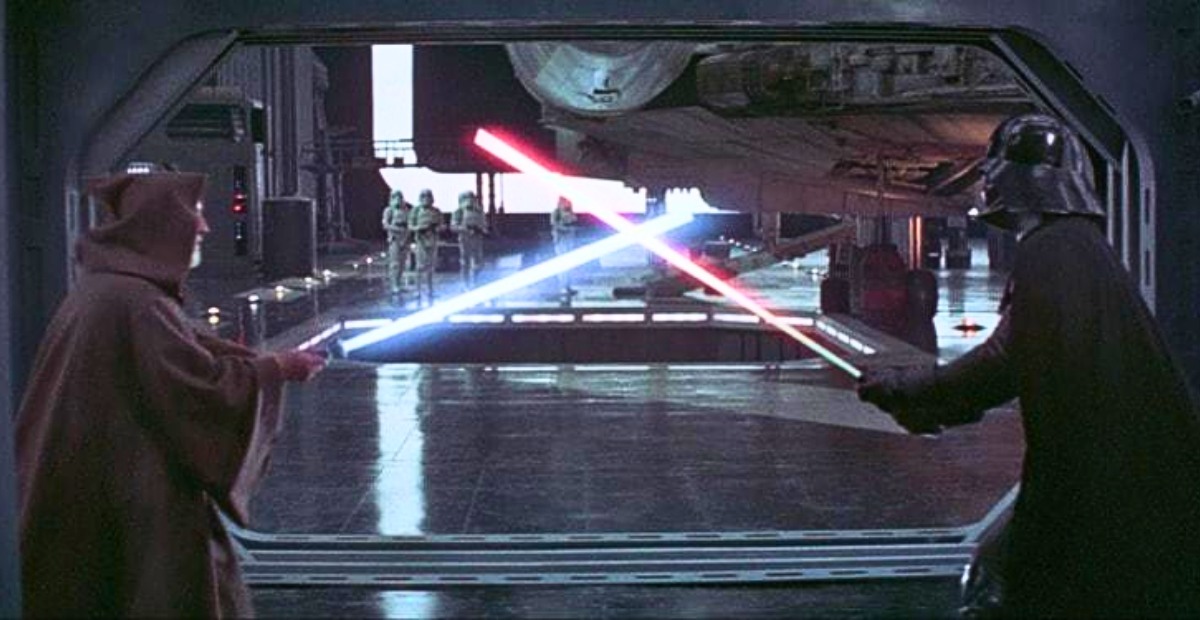The duel between Obi-Wan Kenobi and Darth Vader in Star Wars: A New Hope is often seen as the slowest and least impressive lightsaber fight in the saga. Compared to the fast, acrobatic battles of the prequels or the intense clashes of the sequels, it can look simple — even clumsy — to new viewers. But that simplicity hides one of the most realistic and meaningful duels in all of Star Wars. Once you understand how it’s built, you’ll see it’s a masterclass in control, strategy, and storytelling through combat.
A Duel Between Masters: Strategy Over Spectacle
The Kenobi–Vader duel isn’t meant to be a flashy performance. It’s a fight between two masters who know each other better than anyone else. When warriors reach a certain level of skill — whether in fencing, kendo, or historical sword fighting — their battles often stop being about big, dramatic swings. Instead, they become about small movements, timing, and reading the opponent’s intent.
That’s exactly what we see in this fight. Every step, pause, and swing has a purpose. There’s no wasted movement because neither combatant wants to overcommit. They both know that one mistake could end the fight instantly. This is a concept you’ll find in real martial arts too. In high-level kendo matches, two experts sometimes circle each other for minutes, making only subtle shifts in stance or testing their opponent’s reaction — and then the match is over in a single, precise strike.
This duel follows the same logic. Obi-Wan keeps his blade close and defends carefully, using his mastery of Form III, Soresu — a defensive lightsaber style designed to wear opponents down. Vader, on the other hand, fights with slow, heavy strikes. His cybernetic body limits his agility, so he’s relied more on the Force and adjusted his style to emphasize control and precision. Their approaches are completely different, but both are shaped by decades of experience and a deep understanding of each other’s strengths.
It’s also important to remember that neither man’s goal is a straightforward victory. Obi-Wan isn’t trying to defeat Vader — his mission is to stall long enough for Luke and the others to escape. That’s why he focuses on defense rather than taking risky offensive moves. Vader, confident that he has the upper hand, has no reason to rush. He’s methodical and composed because he believes Kenobi’s defeat is inevitable. What looks like a slow fight is actually a calculated battle of patience and willpower.
A Duel Built on Samurai Philosophy and Cinematic Tradition
The tone and pacing of the fight are no accident. George Lucas built Star Wars on the foundation of classic samurai cinema, especially the work of Japanese director Akira Kurosawa. Films like Seven Samurai, Yojimbo, and The Hidden Fortress weren’t just sword-fighting stories — they were about honor, strategy, and humanity. They used the figure of the samurai to explore deep social and moral conflicts, and their combat scenes often reflected that complexity: long stretches of silence, sudden decisive strikes, and tension that built slowly until it snapped in an instant.
Lucas didn’t just borrow Kurosawa’s tone — he also borrowed his style. Wide shots showing two fighters locked in a battle of will, wipe transitions between scenes, and a strong sense of scale and stillness all echo Kurosawa’s cinematic language. Even the duel between Obi-Wan and Vader has visual similarities to fights in The Hidden Fortress, where the combat isn’t a chaotic brawl but a quiet, deliberate exchange between two people who understand exactly what’s at stake.
There’s also a deeper connection behind the scenes. George Lucas was such a devoted admirer of Kurosawa’s work that he once tried to bring one of the director’s most legendary collaborators into Star Wars: actor Toshiro Mifune. Known for his iconic roles in Seven Samurai and The Hidden Fortress, Mifune was Lucas’s first choice to play Obi-Wan Kenobi — and when that didn’t work out, he was even considered for Darth Vader. According to Mifune’s daughter, he declined the roles because he feared that appearing in a science-fiction film could “cheapen the image of the samurai,” which had been so central to his career.
That decision shows how deeply Star Wars was tied to samurai tradition — not just thematically, but spiritually and even in casting. Even though Mifune never stepped into the galaxy far, far away, his influence — and Kurosawa’s — is woven into its DNA. Darth Vader’s armor resembles a samurai’s helmet and mask. Jedi philosophy mirrors the discipline and honor of the samurai code. And the slow, careful pacing of Kenobi and Vader’s duel feels like it was lifted straight from a Kurosawa film.
A Foundation for All Future Lightsaber Battles
Another reason this fight matters is that it sets the tone for how lightsaber combat evolves throughout the saga. Later duels — from Luke’s chaotic swings in The Empire Strikes Back to his focused, controlled strikes in Return of the Jedi — show a clear progression in how combat reflects character development. The same goes for the prequels, where duels are full of youthful speed and agility, and for Rebels or The Clone Wars, where veteran fighters often rely on quick, decisive moves instead of elaborate choreography.
This evolution mirrors something true in real martial arts: beginners often rely on broad, dramatic movements, while experts learn that minimal, efficient actions are far more effective. The Kenobi–Vader duel represents the peak of that mastery. It’s not a beginner’s fight; it’s the endgame between two veterans who have nothing left to prove.

